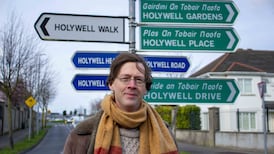DONNIE MacPHERSON :DONNIE MacPHERSON, who has died aged 95, made a living laying gas mains all over England, before returning to his native Dublin in the 1970s to reinvent himself as one of Ireland's leading silversmiths.
Blind in one eye, and with impaired vision in the other, he also founded the Calderwood school to teach the craft to others.
Born in inner city Dublin on the eve of the first World War, he served in the British army as a sergeant in an anti-aircraft unit during the second World War, and saw service in Norway, and at Scapa Flow in the Orkneys in Scotland. He enjoyed the camaraderie of soldiering, but was devastated when he witnessed shellfire wiping out a battery of 13 comrades including his best friend.
It was in that cauldron of conflict the craftsman in him began to take shape.
"During my army career I drank out of a variety of vessels - jam jars, tin cans, even steel helmets. I promised myself that if I survived the war I would make, for my own use, drinking vessels fit for a king - and I did. And what is more I use them every weekend: the silver beaker is in use on Friday, the gold goblet on Saturday, and the platinum beaker is drunk out of on Sunday," he told fashion designer Sybil Connolly who included him in her book Irish Hands (Hearst Books 1995).
Those drinking vessels, known as The Three Graces, are now on display in the National Museum of Ireland, Collins Barracks, Dublin.
Donald MacPherson, known as Donnie, was born in inner city Dublin to a working-class couple. He was the fourth of six children, outliving them all. His father was of Scottish Presbyterian stock, but the family were brought up as Catholics, their mother's religion, as was then customary. In later life, MacPherson described himself as a "bush Baptist". This was his expression of a robust agnosticism, though he made sacred vessels for use in Christian liturgy and had friends of all religions.
He told journalist Kevin Myers that he left Dublin for Liverpool in 1932, with just a spare shirt and a brown paper bag containing egg sandwiches. "I went off to capture the world", travelling around the north of England as a casual farm labourer, sleeping rough when times were hard.
He was taken on as "gentleman's gentleman" by an army officer, who later fixed up a job for him in the gas pipe-laying sector. In his spare time he joined the Territorial army in Lancashire, from which it was a natural progression to full-time service in 1939. MacPherson's brother Dave fought at El Alamein, and died there in 1942.
When war ended MacPhersonreturned to the gas industry and again travelled around England, in somewhat greater comfort this time, working for a contractor laying the gas mains, which were an essential part of Britain's post-war reconstruction. In charge of major projects, he spoke with pride of having extended a gas pipe underneath the railway tracks at Crewe, one of the most complex railway junctions in Britain.
One day on a site near Quorn in Lancashire he made a tiny boiler for a toy steam engine belonging to a colleague, an engineer who declared that MacPherson should have been a coppersmith. This prompted him to sign up for a course in Loughborough college (later university) from which he emerged as a qualified silversmith.
Coming up to retirement age, MacPherson was about to swap the miner's heavy drilling bore for the silversmith's hammer. Around this time, his eyes began to give trouble, and for a brief period he was completely blind.
"Nervous tension, they thought caused it, possibly from the strain of the war, or the responsibilities of the job I was doing. I used to worry about the dangerous conditions my men were working in," he said in an interview published when he was named runner up in the Irish Life (assurance company) pensioner of the year award in 1986. He won a Ford cultural award in 1991.
By then the man who had left Ireland to become a day labourer, a manservant, a soldier, pipe layer and then a general foreman had spent 15 years of his new life as a craftsman producing exquisite goblets and chalices in gold and silver, and beautifully crafted boxes with lids that fitted perfectly.
In Dublin he lived near the family home in Marino, and spent 30 years there producing fine silverware, of which he was often a reluctant seller.
"These are my children," he told one prospective purchaser. "Would you sell your children?"
And they were his children. He regularly visited his pieces on display in Collins Barracks. His last visit was 18 months ago, when his frailty was evident.
Michael Kenny, keeper of the art and industry division at the National Museum, noted that MacPherson had a long relationship with the museum. He asked for MacPherson's help in 1995, when the museum was preparing its new premises. "He agreed that his students in the Calderwood school would provide examples of silver for the new exhibition then beginning to take shape in Collins Barracks.
These objects went on exhibition when the museum opened in 1997. Several other pieces of his, including a tankard and a christening mug acquired by the National Museum may also be seen in Collins Barracks.
MacPherson the silversmith had no time for trivial jewellery. "Trinkets and baubles," he told his niece Maeve MacPherson who studied the craft under him even before he set up the Calderwood school for silversmiths, at Griffith Avenue, Dublin, in 1984.
"He could be fiery - cantankerous was his word to describe it - he wanted the work to be absolutely right but he was . . . generous," she said.
He did not marry. His sister-in-law Rosie MacPherson and his many nephews and nieces survive him.
Donald (Donnie) Stuart MacPherson: born June 23rd, 1914; died October 4th, 2009







